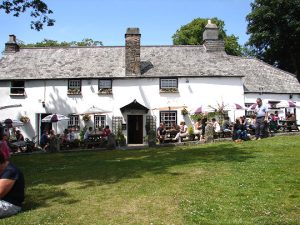The Parish Council is proud to own the Royal Oak Inn, Meavy and pleased to introduce you to our tenant, Joanne Rowe.
Check out their website www.royaloakinn.co.uk
A brief history by Pauline Hamilton-Leggett 2012:
 The Royal Oak Inn, facing the village green in Meavy village, welcomes villagers and visitors alike. An enchanting atmosphere, enticing menu and drinks delight all who step inside. The inn, a former church house which was the pre-Reformation forerunner of the parish hall, is next to St Peter’s church and built within the church yard. The inn was for centuries the property of the church but is now owned by the parish council. There is no record of money paid to the church after 1839 and profits after this were used to assist the school, built on the opposite side of the road in 1837 (now the parish hall). Taken over by the parish council in 1936 the revenue continues to help the parishioners and maintains the inn which is a listed building.
The Royal Oak Inn, facing the village green in Meavy village, welcomes villagers and visitors alike. An enchanting atmosphere, enticing menu and drinks delight all who step inside. The inn, a former church house which was the pre-Reformation forerunner of the parish hall, is next to St Peter’s church and built within the church yard. The inn was for centuries the property of the church but is now owned by the parish council. There is no record of money paid to the church after 1839 and profits after this were used to assist the school, built on the opposite side of the road in 1837 (now the parish hall). Taken over by the parish council in 1936 the revenue continues to help the parishioners and maintains the inn which is a listed building.
The building was probably rebuilt in the sixteenth century and many alterations have been made over the years. A receipt is held in the Plymouth Record Office dated 1589 for half-a-crown for wine and ale purchased by a worker repairing Drake’s Leat. The entrance under the front chimney of the inn was inserted in the early 1800s, the original entrance being under a stone arched doorway to the left. This chimney served a fireplace in the upstairs room which has been suggested was where monks slept as they journeyed across Dartmoor between Buckfast and Buckland abbeys. In 1991 this chimney was leaning at a dangerous angle and Dartmoor National Park insisted that it be restored with the original stone and with a three-inch lean! In 1964 kitchen facilities were removed upstairs and a bar placed each side of the entrance. On the right there is a large inglenook fireplace with two stone ovens. Death watch beetle was found in the interesting ceiling beams in 1966.
The inn takes its name from the ancient oak tree on the green. A Common Oak, Quercus robur, the tree may be a thousand years old. Over a hundred years ago boys recalled riding their bicycles through the gap of the tree and the innkeeper stored peat turves inside the trunk. Tradition has it that nine guests were served dinner in the hollow of the tree by the innkeeper, it being larger than it is today. The smaller tree on the green was grown from an acorn of the old tree and planted in 1920.
In 1899 Sabine Baring-Gould, vicar of Lew Trenchard, wrote that the Meavy oak was a dancing tree. A platform was placed above the canopy of the tree and by climbing a ladder musicians sat up there and played their instruments for villagers to dance on the green at Meavy Fair. The green has been the stage for fairs and pageants over the centuries and a picnic place for families. These fairs were traditionally held in the month of June, near St Peter’s day 29 June, as they still are today. Seats at the higher part of the green were placed there sixty years ago at the Coronation of Queen Elizabeth II.
Soldiers and airmen training on Ringmoor Down and at Harrowbeer aerodrome frequented the Royal Oak during World War II and it was well-loved by the Americans. Filming in the village, with the backdrop of church, inn and tree, has taken place many times for films and television which has brought famous faces to the village. To prevent traffic on the green the surrounding wall was placed there in 1935. The war memorial on the green was put up after WWI. Even the telephone kiosk to the left of the inn is listed by the Department of the Environment for special historic interest.